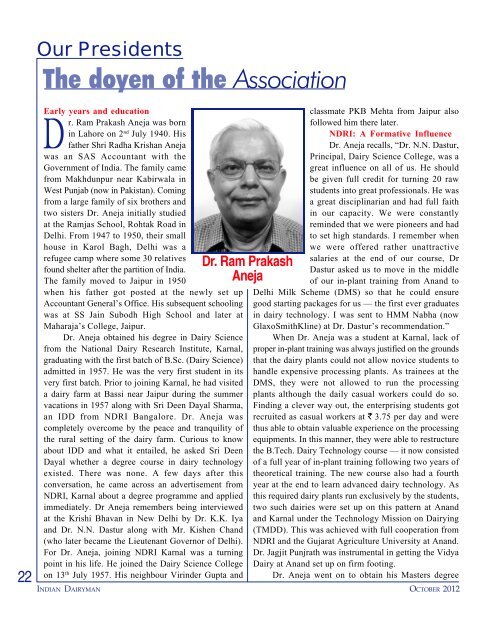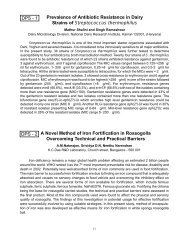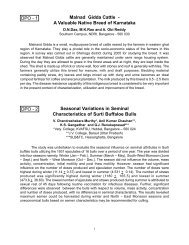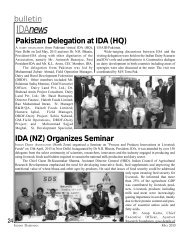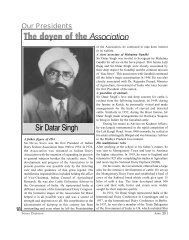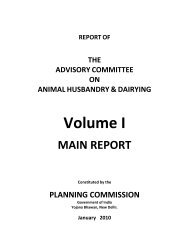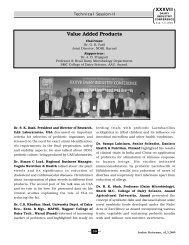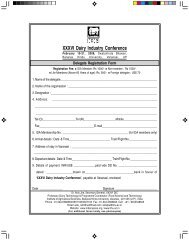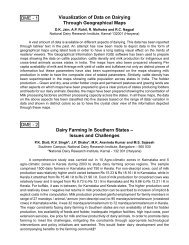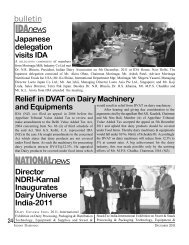OUR PRESIDENTSâDr. R. P. Aneja - Indian Dairy Association
OUR PRESIDENTSâDr. R. P. Aneja - Indian Dairy Association
OUR PRESIDENTSâDr. R. P. Aneja - Indian Dairy Association
Create successful ePaper yourself
Turn your PDF publications into a flip-book with our unique Google optimized e-Paper software.
Our Presidents<br />
The doyen of the <strong>Association</strong><br />
22<br />
Early years and education<br />
Dr. Ram Prakash <strong>Aneja</strong> was born<br />
in Lahore on 2 nd July 1940. His<br />
father Shri Radha Krishan <strong>Aneja</strong><br />
was an SAS Accountant with the<br />
Government of India. The family came<br />
from Makhdunpur near Kabirwala in<br />
West Punjab (now in Pakistan). Coming<br />
from a large family of six brothers and<br />
two sisters Dr. <strong>Aneja</strong> initially studied<br />
at the Ramjas School, Rohtak Road in<br />
Delhi. From 1947 to 1950, their small<br />
house in Karol Bagh, Delhi was a<br />
refugee camp where some 30 relatives<br />
found shelter after the partition of India.<br />
The family moved to Jaipur in 1950<br />
when his father got posted at the newly set up<br />
Accountant General’s Office. His subsequent schooling<br />
was at SS Jain Subodh High School and later at<br />
Maharaja’s College, Jaipur.<br />
Dr. <strong>Aneja</strong> obtained his degree in <strong>Dairy</strong> Science<br />
from the National <strong>Dairy</strong> Research Institute, Karnal,<br />
graduating with the first batch of B.Sc. (<strong>Dairy</strong> Science)<br />
admitted in 1957. He was the very first student in its<br />
very first batch. Prior to joining Karnal, he had visited<br />
a dairy farm at Bassi near Jaipur during the summer<br />
vacations in 1957 along with Sri Deen Dayal Sharma,<br />
an IDD from NDRI Bangalore. Dr. <strong>Aneja</strong> was<br />
completely overcome by the peace and tranquility of<br />
the rural setting of the dairy farm. Curious to know<br />
about IDD and what it entailed, he asked Sri Deen<br />
Dayal whether a degree course in dairy technology<br />
existed. There was none. A few days after this<br />
conversation, he came across an advertisement from<br />
NDRI, Karnal about a degree programme and applied<br />
immediately. Dr <strong>Aneja</strong> remembers being interviewed<br />
at the Krishi Bhavan in New Delhi by Dr. K.K. Iya<br />
and Dr. N.N. Dastur along with Mr. Kishen Chand<br />
(who later became the Lieutenant Governor of Delhi).<br />
For Dr. <strong>Aneja</strong>, joining NDRI Karnal was a turning<br />
point in his life. He joined the <strong>Dairy</strong> Science College<br />
on 13 th July 1957. His neighbour Virinder Gupta and<br />
classmate PKB Mehta from Jaipur also<br />
followed him there later.<br />
NDRI: A Formative Influence<br />
Dr. <strong>Aneja</strong> recalls, “Dr. N.N. Dastur,<br />
Principal, <strong>Dairy</strong> Science College, was a<br />
great influence on all of us. He should<br />
be given full credit for turning 20 raw<br />
students into great professionals. He was<br />
a great disciplinarian and had full faith<br />
in our capacity. We were constantly<br />
reminded that we were pioneers and had<br />
to set high standards. I remember when<br />
we were offered rather unattractive<br />
salaries at the end of our course, Dr<br />
Dr. Ram Prakash<br />
Dastur asked us to move in the middle<br />
<strong>Aneja</strong><br />
of our in-plant training from Anand to<br />
Delhi Milk Scheme (DMS) so that he could ensure<br />
good starting packages for us — the first ever graduates<br />
in dairy technology. I was sent to HMM Nabha (now<br />
GlaxoSmithKline) at Dr. Dastur’s recommendation.”<br />
When Dr. <strong>Aneja</strong> was a student at Karnal, lack of<br />
proper in-plant training was always justified on the grounds<br />
that the dairy plants could not allow novice students to<br />
handle expensive processing plants. As trainees at the<br />
DMS, they were not allowed to run the processing<br />
plants although the daily casual workers could do so.<br />
Finding a clever way out, the enterprising students got<br />
recruited as casual workers at ` 3.75 per day and were<br />
thus able to obtain valuable experience on the processing<br />
equipments. In this manner, they were able to restructure<br />
the B.Tech. <strong>Dairy</strong> Technology course — it now consisted<br />
of a full year of in-plant training following two years of<br />
theoretical training. The new course also had a fourth<br />
year at the end to learn advanced dairy technology. As<br />
this required dairy plants run exclusively by the students,<br />
two such dairies were set up on this pattern at Anand<br />
and Karnal under the Technology Mission on <strong>Dairy</strong>ing<br />
(TMDD). This was achieved with full cooperation from<br />
NDRI and the Gujarat Agriculture University at Anand.<br />
Dr. Jagjit Punjrath was instrumental in getting the Vidya<br />
<strong>Dairy</strong> at Anand set up on firm footing.<br />
Dr. <strong>Aneja</strong> went on to obtain his Masters degree<br />
INDIAN DAIRYMAN OCTOBER 2012
Dr. <strong>Aneja</strong> took over as President of <strong>Indian</strong> <strong>Dairy</strong> <strong>Association</strong> (IDA) in 1990,<br />
leading the <strong>Association</strong> on two occasions. His first term was during 1990‐91 and the<br />
second during 1993‐94. He was the 16th President of IDA. His ties with the <strong>Association</strong>,<br />
which go back a long way, continue to thrive till today. The erudite dairyman's is<br />
a saga of innovation, enterprise and industry at every stage of his life.<br />
in <strong>Dairy</strong> & Food Science from the University of<br />
Saskatchewan, Canada and a Ph.D. from the Gujarat<br />
Agriculture University.<br />
He started his career by working in <strong>Dairy</strong> Plants<br />
at the Delhi Milk Scheme, Horlicks, and then Hindustan<br />
Lever. Subsequently, he taught <strong>Dairy</strong> Technology &<br />
Plant Management at the <strong>Dairy</strong> Technology Institute,<br />
Bombay, before moving on to Canada for higher education.<br />
Noteworthy stint at NDDB<br />
The eminent dairyman was with the National <strong>Dairy</strong><br />
Development Board (NDDB) right from its formative<br />
years till 1990. In 1978 he was appointed the Secretary<br />
of NDDB. He was instrumental in the planning and<br />
implementation of Operation Flood I, II and III projects.<br />
He was also responsible for the planning and<br />
implementation of NDDB’s vegetable oil and oil seeds<br />
project. Dr <strong>Aneja</strong> was an Ex-Officio Additional Secretary<br />
to the Government of India, Ministry of Agriculture,<br />
Department of Agriculture Research &<br />
Education, and Director Technology<br />
Mission on <strong>Dairy</strong>ing.<br />
During Dr. <strong>Aneja</strong>’s tenure as one<br />
of the Chief Executives of the NDDB<br />
and IDC (<strong>Indian</strong> <strong>Dairy</strong> Corporation), the<br />
annual rate of growth of the organized<br />
dairy sector touched its peak of 20-25%.<br />
He was also responsible for setting up<br />
the Sugam <strong>Dairy</strong> at Vadodara, which<br />
pioneered the manufacture of traditional<br />
<strong>Indian</strong> milk products on an industrial scale.<br />
He holds several patents largely for the<br />
manufacture of traditional <strong>Indian</strong> milk<br />
products.<br />
After taking voluntary retirement from the NDDB<br />
in 1990 at the age of 50, Dr <strong>Aneja</strong> established himself<br />
as an international consultant in dairy and agricultural<br />
development projects.<br />
IDA beckons…<br />
Dr. <strong>Aneja</strong> took over as President of <strong>Indian</strong> <strong>Dairy</strong><br />
<strong>Association</strong> (IDA) in 1990, leading the <strong>Association</strong> on<br />
two occasions. His first term was during 1990-91 and<br />
the second during 1993-94. He had now moved to<br />
New Delhi from Anand and since he resided very<br />
close to IDA House, was able to devote much time to<br />
the <strong>Association</strong>. He recalls the improvements that were<br />
made to the <strong>Indian</strong> <strong>Dairy</strong>man to make it more attractive<br />
to the stakeholders. He has fond memories of the<br />
assistance he received from the IDA staff, particularly<br />
Mr. Altaf who was the key officer of the IDA at the<br />
time. <strong>Indian</strong> <strong>Dairy</strong>man was also put on the PageMaker<br />
through a local area network that was set up at that<br />
OCTOBER 2012<br />
<br />
Dr. <strong>Aneja</strong> with Mr. Rajiv Gandhi<br />
and Mrs. Sonia Gandhi<br />
INDIAN DAIRYMAN<br />
23
24<br />
Our Presidents<br />
time. IDA also directly organized the <strong>Dairy</strong> Industry<br />
Conference in New Delhi, which was an important<br />
milestone.<br />
Dr. <strong>Aneja</strong> had joined the IDA as a student member<br />
in 1957 and therefore has a long association with it.<br />
He has published a large number of papers/articles in<br />
the <strong>Indian</strong> <strong>Dairy</strong>man and the <strong>Indian</strong> Journal of<br />
<strong>Dairy</strong> Science. He was the Chief Editor of IDA<br />
during 1978-79. He recalls the pleasure of having worked<br />
with Dr. P. Bhattacharya and Dr. S.C. Ray who were<br />
instrumental in building the IDA House. An incident<br />
which rightly piqued him was when he was asked to<br />
renew his (life) membership — he complained about<br />
it to Mr. Gopinath, the then President of IDA. He had<br />
seen the IDA office in the ‘Barsati’ of the IDC Office<br />
in Greater Kailash. What a story of perseverance!<br />
He recalls the difficulties the <strong>Association</strong> faced when<br />
its charter was changed from the <strong>Indian</strong> <strong>Dairy</strong> Science<br />
<strong>Association</strong> (IDSA) to the <strong>Indian</strong> <strong>Dairy</strong> <strong>Association</strong><br />
(IDA), as many scientists believed at that time that<br />
the role of science would diminish in the <strong>Association</strong>.<br />
Fortunately that never happened.<br />
During his tenure, prominent coverage was given<br />
to local dairy activities (like Aarey news, Haringhata<br />
news, and DMS news) which kept members updated.<br />
Dr. <strong>Aneja</strong> notes with satisfaction that such reportage,<br />
in contemporary times, is much more detailed, informative<br />
and topical — thanks to technology and the industrious<br />
IDA staff.<br />
An incident that caused considerable distress was<br />
the cases filed by IDA vs. IDA during Mr. PH Bhatt’s<br />
presidency. But time being a great healer, these issues<br />
ultimately got resolved. Another important contribution<br />
of Dr. <strong>Aneja</strong> was that he was instrumental in getting<br />
the Dr. Kurien Award instituted.<br />
In recognition of meritorious service to the dairy industry<br />
Dr. <strong>Aneja</strong> was awarded the Fellowship of the IDA in 1989<br />
at the <strong>Dairy</strong> Industry Conference held at Hyderabad.<br />
A Global Icon<br />
While living in New Delhi in the early 90’s, Dr.<br />
<strong>Aneja</strong> taught at the FORE School of Management, helped<br />
set up the FORE Institute of Rural Management and<br />
participated in setting up an NGO for rural development<br />
in Chamba (HP). He was also a member of the Planning<br />
Commission’s High Powered Committee to make<br />
recommendations on suitable institutional structure for<br />
rural development. His wealth of experience and expertise<br />
led him to assist the Bankers Institute of Rural<br />
Development (BIRD Lucknow) in a study of the dairy<br />
sectors of Bangladesh, Pakistan and Sri Lanka for SAARC<br />
drawing up long-term plans and policies for dairy<br />
development in these countries. During this period Dr<br />
<strong>Aneja</strong> also completed a study of the dairy sectors<br />
in Indonesia, Philippines and Thailand for the FAO.<br />
He also authored a monograph on Operation<br />
Flood — A Success Story for the FAO/APHCA<br />
Bangkok.<br />
He also served as the Team Leader of the<br />
UNDP/FAO team that assessed the R&D<br />
requirements of the Technology Mission on<br />
Oilseeds, Government of India. Dr. <strong>Aneja</strong> then<br />
moved to Kenya for a year as the Team Leader<br />
of the Policy Planning Team under the Agriculture<br />
Sector Management Project (ASMPII) funded by<br />
the World Bank. As a result of the move to Kenya,<br />
Dr. <strong>Aneja</strong> resigned as the President of IDA in<br />
December 1994 and handed over the charge to<br />
the then Vice President Shri Animesh Banerjee.<br />
<br />
Her Majesty Queen Beatrix and His Royal Highness<br />
Prince Claus of the Netherlands with Dr. <strong>Aneja</strong> at the<br />
Product Development Laboratory of NDDB, Anand.<br />
INDIAN DAIRYMAN OCTOBER 2012
Dr. <strong>Aneja</strong> with the then President of India<br />
Giani Zail Singh<br />
After a successful assignment in Kenya, Dr. <strong>Aneja</strong> joined<br />
a Commonwealth Secretariat Team to look at the situation<br />
of the dairy sector in Jamaica and make recommendations<br />
on exploring its full potential. The Government of Jamaica<br />
requested the Commonwealth Secretariat to depute Dr.<br />
<strong>Aneja</strong> to assist in implementing the recommendations.<br />
Dr. <strong>Aneja</strong> moved to Kingston, Jamaica for three years<br />
to work for the Commonwealth Secretariat, as the <strong>Dairy</strong><br />
Development Adviser to the Government of Jamaica.<br />
During this period, he helped set up the <strong>Dairy</strong> Board of<br />
Jamaica as well as the Jamaica <strong>Dairy</strong> Farmers Federation.<br />
One of the advisors to the Jamaican Government was<br />
the Chairman of the <strong>Dairy</strong> Farmers of Canada, Mr.<br />
Jacques Lafarge who subsequently invited Dr <strong>Aneja</strong> to<br />
assist in setting up a new project for the New Brunswick<br />
<strong>Dairy</strong> Farmers Cooperative in Miramichi, NB Canada<br />
for production and marketing of traditional <strong>Indian</strong> dairy<br />
products. Dr. <strong>Aneja</strong> was in Canada from 2001 to 2003.<br />
Mr. V.S. Behla with his vast experience in<br />
implementing Operation Flood replaced him in Jamaica<br />
to strengthen the newly formed <strong>Dairy</strong> Federation.<br />
While in Canada, Dr. <strong>Aneja</strong> along with Dr. R.C.<br />
Chandan, Dr. B.N. Mathur and Dr. Asim Kumar<br />
Banerjee, completed a well-illustrated book on Technology<br />
of <strong>Indian</strong> Milk Products at the request of Mr. P.R.<br />
Gupta whose labour of love saw this book published.<br />
Since 1983 Dr. <strong>Aneja</strong> had encouraged and assisted<br />
Mr. Gupta to bring out an annual compendium on the<br />
<strong>Indian</strong> dairy industry entitled “<strong>Dairy</strong> India”.<br />
OCTOBER 2012<br />
Man with a mission…<br />
Dr. <strong>Aneja</strong> was always interested in natural<br />
resource utilization and energy conservation. One<br />
of his earlier papers published in the <strong>Indian</strong> <strong>Dairy</strong>man<br />
was on the intensity of energy use in milk processing<br />
and packaging, comparing glass bottles, poly pouches,<br />
bulk vending etc. The development of energy efficient<br />
processing equipment particularly condensing and<br />
drying machinery was a natural part of the R&D<br />
efforts at NDDB.<br />
One of the most significant (and least known)<br />
academic works done at the NDDB was to study<br />
the efficiency of energy conversion in India's milk<br />
production system. The study carried out in the early<br />
seventies under the leadership of Prof. Michael Halse,<br />
FAO Advisor to the NDDB had pointed out the<br />
possibilities of increasing India's milk production multiple<br />
times without the need of sparing much land for milk<br />
production by merely increasing the conversion<br />
efficiencies. Dr. <strong>Aneja</strong> was one of the contributors to<br />
the study by which Prof. Michael Halse subsequently<br />
completed his Ph.D. requirements at the Harvard<br />
Business School.<br />
Career milestones<br />
Dr. <strong>Aneja</strong> says that he started with the planning<br />
of Operation Flood Project and manpower development.<br />
Preparing perspective plans for dairy development in<br />
the participating states was a great challenge in the<br />
absence of reliable data. They were able to achieve<br />
this task with the cooperation of the state agencies<br />
setting up a comprehensive Management Information<br />
Service (MIS) that helped monitor the implementation<br />
of these plans and operate the National Milk Grid (NMG).<br />
The renowned scientist says that the satisfaction of<br />
seeing the emergence of the milk grid right before<br />
their eyes would not have been possible without the<br />
hard work put in by Shailendra Kumar, R.K. Nagar<br />
etc.<br />
Dr. <strong>Aneja</strong> was always interested in research and<br />
development, particularly product development. Steve<br />
Jobs, the founder of Apple Inc, once famously said —<br />
INDIAN DAIRYMAN<br />
25
Our Presidents<br />
‘Innovation distinguishes between a leader and a<br />
follower’. One can say that the quotation aptly describes<br />
Dr. <strong>Aneja</strong>’s spirit of innovation and enterprise. He<br />
says, “The setting up of the Sugam <strong>Dairy</strong> at Baroda<br />
and the many processes we developed for the industrial<br />
manufacture of shrikhand, gulabjamun, khoa, paneer<br />
etc reinforced the place of our indigenous dairy products<br />
in the dairy sector. We also helped develop mini milko<br />
testers that are a great success. All this was possible<br />
because of the support received from professionals<br />
like M.N. Vyas, Dev Gupta, PV Mathew, Dr. SV<br />
Pilkhane and TN Murti.”<br />
Inspirations and Influences<br />
Several people cross our paths during our lifetime<br />
but there are some who leave a profound and lasting<br />
impression on our psyche. The great dairyman pays<br />
tribute to those who inspired him:<br />
“Dr. N.N. Dastur, Dr. K.K. Iya along with many<br />
other great teachers moulded us to face the challenges<br />
of our profession and life in general. The twenty students<br />
in the first batch became lifelong friends and a great<br />
source of strength to each other. Sham Chaudhary<br />
stands out as someone who helped me inculcate good<br />
values throughout my career. I was fortunate to have<br />
worked with great professionals. Amongst them were<br />
Mr. Bedekar and Fergus Kelly at HMM Nabha, Dr.<br />
A.P. Mahadevan and MG Mohoni at HLL Etah and<br />
YR Karnik at the <strong>Dairy</strong> Technology Institute Bombay.<br />
Mention must also be made of S.M. Shetty who was<br />
Training Superintendent (Economics) while I taught dairy<br />
technology. S.M. Shetty was a student of Prof. Brahma<br />
Nand at The Department of Economics in Bombay<br />
University who in turn was greatly influenced by Prof.<br />
Laski of the London School of Economics. This association<br />
with S.M. Shetty helped bring me greater awareness<br />
on the broader issues of poverty and the great economic<br />
divide in India. It opened my eyes to the economic<br />
realities in India.<br />
Later on it was at IIM Ahmedabad that Prof.<br />
Michael Halse gave an entirely new focus to India's<br />
agriculture and dairying. That exposure greatly helped<br />
me understand the sector from a purely managerial<br />
perspective and the related policy issues. Prof. Halse<br />
was a mentor to a large number of professionals both<br />
at NDDB and IRMA. His role though not recognized<br />
generally, in building the dairy industry of India will be<br />
always be etched in our hearts and minds.<br />
The dairy sector in India has had some great people<br />
contribute to its growth. Some are very well known<br />
names like Dr. P. Bhattacharya, Dr. D.N. Khurody,<br />
The first batch of NDRI graduates with Dr. K.K. Iya and Dr. N.N. Dastur<br />
Standing second from left is Dr. R.P. <strong>Aneja</strong><br />
26<br />
INDIAN DAIRYMAN OCTOBER 2012
OCTOBER 2012<br />
<br />
The complete picture!<br />
Dr. <strong>Aneja</strong> with his family<br />
Dr. S.C. Ray, Mr. H.M. Dalaya, Dr. V.H. Shah, Mr.<br />
A.K. Ray Chaudhary, Mr. G.M. Jhala, and Dr. Amrita<br />
Patel etc. who all contributed very significantly. However<br />
many of the contributions have gone unnoticed. Some,<br />
that come to my mind are the contributions made by<br />
Mr. N. Rajagopal the then Joint Secretary (<strong>Dairy</strong><br />
Development,GOI), Mr. G.V.K. Rao the then Secretary<br />
to the Ministry of Agriculture, GOI and Mr. T.N. Seshan<br />
who was later the Cabinet Secretary and Chief Election<br />
Commissioner of India.<br />
Working with the legend<br />
Working with Dr. Verghese Kurien for over 24<br />
years was a blessing. He led from the front and was<br />
totally committed to the dairy farmers of India showing<br />
the thoroughness that was needed to handle the<br />
tremendous challenges facing us. He was able to muster<br />
support at the highest levels in the country which helped<br />
in the successful implementation of Operation Flood.<br />
His real strength came from the farmers supported by<br />
professionals working for them. This is an unbeatable<br />
combination. I was lucky to have a ringside seat and<br />
watch events unfold as they did to make the country a<br />
leader in milk and milk products. My only regret is that<br />
we missed the opportunity of merging NDDB and IDC<br />
with NCDFI after the Jha Committee report on Operation<br />
Flood. That would have made the dairy cooperatives<br />
supreme in handling the affairs of the dairy farmers.<br />
Speaking of his immediate family Dr. <strong>Aneja</strong> says<br />
“I was truly blessed to have had a very upright father<br />
and a loving mother who supported me unconditionally.<br />
My father could not get the education that he wanted<br />
and knew the value of higher learning. I was given<br />
whatever was needed to pursue my goals. The values<br />
of honesty, hard work and faith in the Lord were inculcated<br />
in me from my parents. Later on, I was lucky to have<br />
married Rama who gave up her career as a Doctor to<br />
look after our two daughters, Punita and Urmi. Both<br />
our daughters, son-in-laws and grandchildren have been<br />
sources of great strength and joy to us.”<br />
A Humanitarian to the core<br />
Dr <strong>Aneja</strong>’s philosophy of life can be gleaned from<br />
his thoughts reproduced below:<br />
“Everyone has purpose on this earth. Some are<br />
lucky to have it spelled out for them. Some struggle to<br />
find their mission. I was just lucky that my path was<br />
clearly spelled out and at every turning point there<br />
were clear signals. I came to India from Canada to<br />
get married and found a wonderful life partner.<br />
Subsequently I ran into Michael Halse who prompted<br />
me to join the NDDB. This made me stay back at<br />
Anand for the next 24 years and I enjoyed very moment<br />
of a very satisfying professional life. All the values<br />
that were inculcated over my earlier years came in<br />
handy. It is the process that is important and the end<br />
result will ultimately be good. India has always produced<br />
generations of people seeped in our timeless values of<br />
honesty, sense of purpose, hard work and compassion.<br />
The guiding principle has always been Love All Serve<br />
All.<br />
The damage done to the rich by the poverty in<br />
India is far greater than the misery it causes to the<br />
poor. The rich are refusing to see the reality and are<br />
living in virtual bubbles. When the bubbles burst, the<br />
reality will dawn on them in the most horrific manner.<br />
INDIAN DAIRYMAN<br />
27
Our Presidents<br />
Dr. <strong>Aneja</strong> continues to pursue his lifelong mission of development of<br />
industrial processes for the manufacture of traditional <strong>Indian</strong> dairy products<br />
so that they find their rightful place in the global market.<br />
28<br />
I was lucky to have seen poverty in the raw. An<br />
incident comes to my mind when we lived in a small<br />
village, Navli (near Jaipur, Rajasthan) where my wife<br />
was posted as a Medical Officer at the Primary Health<br />
Centre. One day our neighbor's wife did not turn up to<br />
pick up our one year old daughter whom they loved<br />
and took care of while both of us went to work. So I<br />
went to their house and it was quite clear from the long<br />
drawn faces of everyone in the family that someone<br />
had died in the family. I then asked one of the older<br />
sons as to what had happened? I was told that the<br />
buffalo died. For me it was just a question of an economic<br />
loss but for the family it seemed to be a calamity. The<br />
good lady then explained to me that her husband who<br />
usually squanders away the money out of the annual<br />
crop would not provide the money to buy another buffalo<br />
to keep her and the entire family totally under his control.<br />
Money earned from milk was hers to keep and that<br />
took care of the day-to-day expenses giving her the<br />
independence to look after the kids and their education.<br />
That opened my eyes to the importance of the work<br />
we were doing. It was quite clear that Dr. Kurien had<br />
motivated a lot of professionals to dedicate their lives<br />
to this noble cause of helping the rural poor who got as<br />
much of half of their incomes from milk. That made us<br />
all at NDDB, missionaries.<br />
Fortunately for me the Market Intervention<br />
Operation in Oils (MIO) was a God sent opportunity<br />
to serve the country. My last two years in the NDDB<br />
were known for the success that we achieved in making<br />
the country self-sufficient in oilseeds and edible oils<br />
through the Technology Mission on Oilseeds and the<br />
Market Intervention Operation that I was handling.<br />
Thanks to the tremendous support we received from<br />
Dr. P.V. Shenoy who was the Mission Director and<br />
his successor Mr. M. Moses along with Mr. K.R.<br />
Rao who was deputed to the Technology Mission from<br />
NDDB. Mr. G.K. Sood of the Vanaspati Manufacturers<br />
<strong>Association</strong> of India was particularly helpful with his<br />
knowledge of the oilseed sector. India achieved selfsufficiency<br />
in oilseeds within three years — a feat that<br />
needed a lot of planning and full support from everyone<br />
in the Government. I wish we could do the same in the<br />
energy sector. Dr. Kurien could have done that.<br />
Since NDDB salaries at that time were aligned to<br />
the government salaries and working at Anand was<br />
more a labor of love, I needed to earn for my retirement.<br />
Well-paying assignments came my way as result of<br />
what we had achieved at Anand. The Lord looked<br />
after us and now in retirement, I am able to contribute<br />
to the Sri Sathya Sai Institute of Higher Learning at<br />
Puttaparthy in Andhra Pradesh by telling stories of what<br />
you can achieve if you have faith and confidence and<br />
His grace.”<br />
Unrelenting zeal: The mission continues<br />
On his return to India from Canada in November<br />
2003 Dr. and Mrs. <strong>Aneja</strong> went for a pilgrimage to<br />
Puttaparthy, the abode of Sri Sathya Sai Baba. Mr.<br />
S.V. Giri , the Vice Chancellor of the Sri Sathya Sai<br />
Institute of Higher Learning invited the erudite Dr. <strong>Aneja</strong><br />
as Visiting Faculty at the Department of Economics<br />
which was headed by Prof. V.N. Pandit (a well-known<br />
economist from Delhi School of Economics).<br />
Dr. <strong>Aneja</strong> continues to pursue his lifelong mission<br />
of development of industrial processes for the manufacture<br />
of traditional <strong>Indian</strong> dairy products so that they find<br />
their rightful place in the global market. Currently a<br />
visiting faculty member in the Dept. of Economics at<br />
the Sri Sathya Sai Institute of Higher Learning, he offers<br />
a course in Natural Resource and Energy Economics.<br />
It has rightly been said, "Greatness is not found<br />
in possessions, power, position, or prestige. It is<br />
discovered in goodness, humility, service and<br />
character." Dr. <strong>Aneja</strong>, untiring in spirit and mind<br />
and unmatched in ability and enterprise, truly<br />
embodies this saying. With his wealth of experience<br />
and expertise, the multifaceted genius continues to<br />
lead from the front. IDA and the entire dairy sector<br />
is privileged to have amongst its midst a dairyman<br />
par excellence!<br />
INDIAN DAIRYMAN OCTOBER 2012


